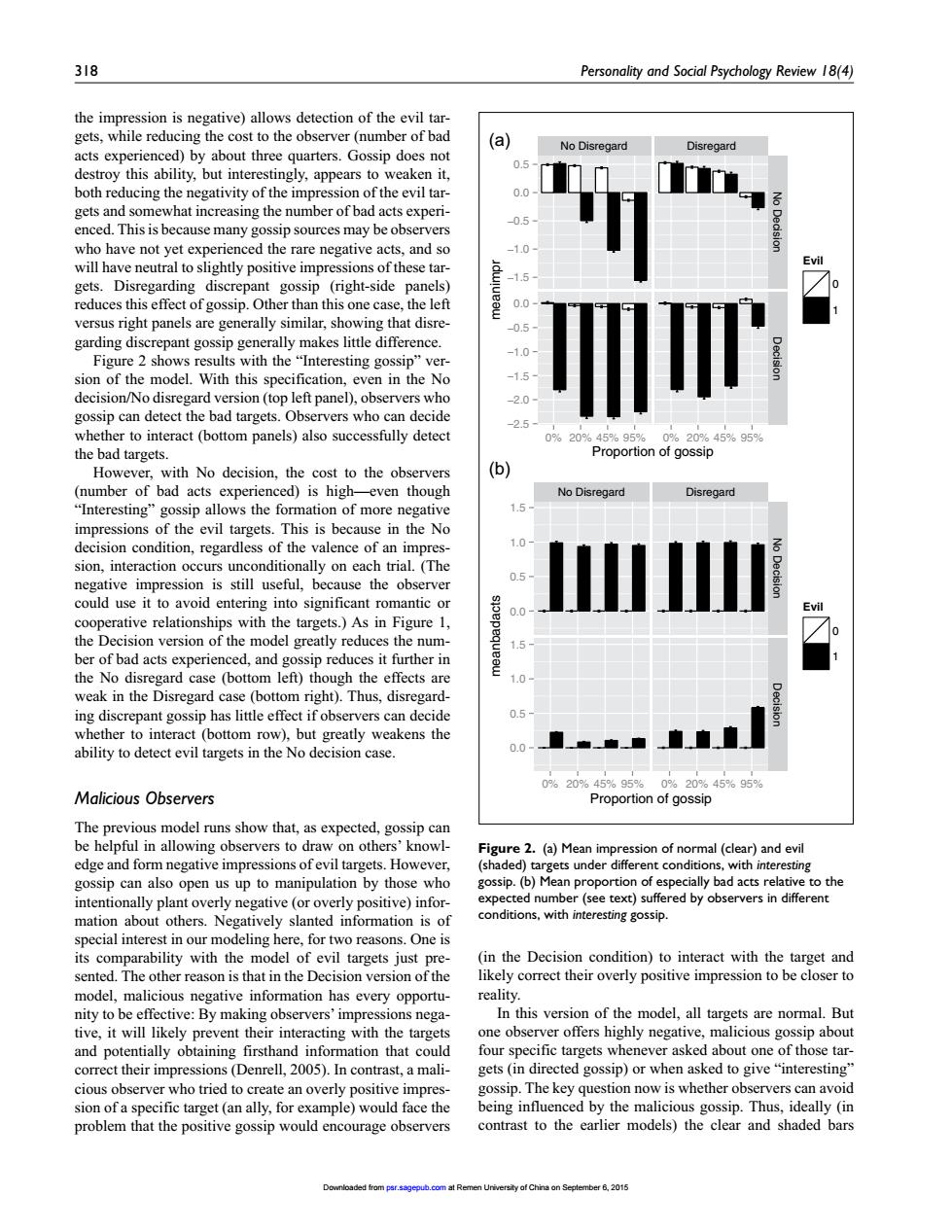正在加载图片...

318 Personality and Social Psychology Review 1(4) the im sion is negative)allow a Disregard acts experienced)by about three quarters.Gossip does not destroy th s ab lity,but inter ungly,appears to eaken i h d so r of bad eev enced.This is because many gossip sources may be observers who have not yet experienced the rare negative acts,and so 10 will ha positive impre -1 0.0 versus right panels are generally similar,showing that disre- 15 CasnoaegadnsionOpIepamelnobsccswh9 gossip can detect the bad targets.Obs vers who can decide -2 r to interact (bottom panels)also successfully detect Proportion of gos % with No decision.the cost to the obse (b) (number of bad acts experienced)is high-even though No Disregard "Interesting"gossip allows the formation of more negative he evil the No ach trial.(The negative impression is still useful,because the observer could use it to avoi romantic or of had acts exper nced and g reduces it further in 1.0 we (bo ssin ha m ngnt).Inus,dis 1 05 ability to detect evil targets in the No decision case. 0%20 5%95 Malicious Observers Pro ure 2.(a)Mean impr ession of normal (clear)and evil edge and for negative impre 0 ent cond the mation about others n atively slanted information is of evil targets e De nalicious negative information ha eality nity to be effective:By making observers'impr ions nega- In this version of the model,all targets are normal.But tive,it will likely prevent their interacting one observ r offers highly negat p abou tha rets (in dire ssin)or when asked to ious observer who tried to create an overly nositive i sip.The key question now is whether observers can avoid sion of a specific target(an ally,for example)would face the problem that the positive gossip would encourage observers contrast to the earlier models)the clear and shaded bar318 Personality and Social Psychology Review 18(4) the impression is negative) allows detection of the evil targets, while reducing the cost to the observer (number of bad acts experienced) by about three quarters. Gossip does not destroy this ability, but interestingly, appears to weaken it, both reducing the negativity of the impression of the evil targets and somewhat increasing the number of bad acts experienced. This is because many gossip sources may be observers who have not yet experienced the rare negative acts, and so will have neutral to slightly positive impressions of these targets. Disregarding discrepant gossip (right-side panels) reduces this effect of gossip. Other than this one case, the left versus right panels are generally similar, showing that disregarding discrepant gossip generally makes little difference. Figure 2 shows results with the “Interesting gossip” version of the model. With this specification, even in the No decision/No disregard version (top left panel), observers who gossip can detect the bad targets. Observers who can decide whether to interact (bottom panels) also successfully detect the bad targets. However, with No decision, the cost to the observers (number of bad acts experienced) is high—even though “Interesting” gossip allows the formation of more negative impressions of the evil targets. This is because in the No decision condition, regardless of the valence of an impression, interaction occurs unconditionally on each trial. (The negative impression is still useful, because the observer could use it to avoid entering into significant romantic or cooperative relationships with the targets.) As in Figure 1, the Decision version of the model greatly reduces the number of bad acts experienced, and gossip reduces it further in the No disregard case (bottom left) though the effects are weak in the Disregard case (bottom right). Thus, disregarding discrepant gossip has little effect if observers can decide whether to interact (bottom row), but greatly weakens the ability to detect evil targets in the No decision case. Malicious Observers The previous model runs show that, as expected, gossip can be helpful in allowing observers to draw on others’ knowledge and form negative impressions of evil targets. However, gossip can also open us up to manipulation by those who intentionally plant overly negative (or overly positive) information about others. Negatively slanted information is of special interest in our modeling here, for two reasons. One is its comparability with the model of evil targets just presented. The other reason is that in the Decision version of the model, malicious negative information has every opportunity to be effective: By making observers’ impressions negative, it will likely prevent their interacting with the targets and potentially obtaining firsthand information that could correct their impressions (Denrell, 2005). In contrast, a malicious observer who tried to create an overly positive impression of a specific target (an ally, for example) would face the problem that the positive gossip would encourage observers (in the Decision condition) to interact with the target and likely correct their overly positive impression to be closer to reality. In this version of the model, all targets are normal. But one observer offers highly negative, malicious gossip about four specific targets whenever asked about one of those targets (in directed gossip) or when asked to give “interesting” gossip. The key question now is whether observers can avoid being influenced by the malicious gossip. Thus, ideally (in contrast to the earlier models) the clear and shaded bars No Disregard Disregard 1.5 1.0 0.5 0.0 0.5 2.5 2.0 1.5 1.0 0.5 0.0 No Decision Decision 0% 20% 45% 95% 0% 20% 45% 95% Proportion of gossip meanimpr Evil 0 1 No Disregard Disregard 0.0 0.5 1.0 1.5 0.0 0.5 1.0 1.5 No Decision Decision 0% 20% 45% 95% 0% 20% 45% 95% Proportion of gossip meanbadacts Evil 0 1 (a) (b) Figure 2. (a) Mean impression of normal (clear) and evil (shaded) targets under different conditions, with interesting gossip. (b) Mean proportion of especially bad acts relative to the expected number (see text) suffered by observers in different conditions, with interesting gossip. Downloaded from psr.sagepub.com at Remen University of China on September 6, 2015